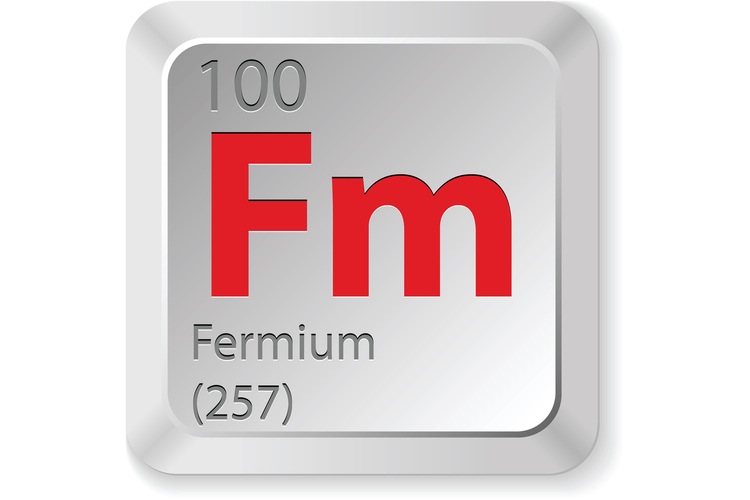Facts About Fermium

Atomic Number: 100 Atomic Symbol: Fm Atomic Weight: 257 Melting Point: 2,781 F (1,527 C) Boiling Point: Unknown
Word Origin: Fermium was named for Italian physicist and Nobel Laureate Enrico Fermi, who developed the first artificial, self-sustaining nuclear reactor. He was recently deceased at the time of the element’s discovery.
Discovery: In 1952, fermium was discovered from the fallout of the “Ivy Mike” ten-megaton nuclear test in the South Pacific. This was the first successful hydrogen fusion bomb detonation, and it also produced einsteinium.
Fermium was officially identified by Albert Ghiorso and his team when they returned from the South Pacific to their labs at University of California, Berkeley and studied coral from the test site. They found 255Fm, a daughter of einsteinium isotope beta decay. Fermium’s discovery was kept under wraps until 1955 on orders from the U.S. military, due to Cold War tensions.
Properties of fermium
As the heaviest synthetic element that can be formed by neutron bombardment of lighter elements, fermium is the heaviest element that can be prepared in macroscopic quantities. [See Periodic Table of the Elements]
Fermium metal has not been prepared, though alloys with rare earth metals have been produced. The alloy of fermium and ytterbium is shiny and silver. Measurements and predictions have been made from that and other alloys. It has been deduced that fermium metals will be usually in a divalent state but could form a trivalent state with modest compression.
Fermium’s chemical properties have been studied only with tracer amounts requiring innovative experimental techniques. It has been discovered that fermium’s chemistry is typical of late actinides, with a III oxidation state prevailing but also a tendency toward a II oxidation state present.
There are 21 known isotopes of fermium, which range in atomic weights from 242 to 260. Two are metastable. The most stable is 257Fm with a half-life of 100.5 days. The neutron-capture product of 257Fm, 258Fm, undergoes spontaneous fission and has a half-life of just 370 microseconds.
Though fermium is difficult to obtain, pure 255Fm can be easily isolated by "milking" the beta-decay daughter of pure 255Es.
Sources of fermium
Fermium is artificially produced, though it did occur naturally once, with einsteinium, at the natural nuclear fission reactor at Oklo, Gabon. The element no longer exists at that site, however.
Fermium production is the result of multiple neutron captures in lighter elements, such as uranium and curium, followed by successive beta decays. These events happen most often when there is an increased neutron flux — the most powerful instance of which is a nuclear explosion. That is why it was discovered after the Ivy Mike explosion.
It can also be produced at nuclear reactors or accelerators, when lighter actinides are bombarded with neutrons. Twenty- to 200-kiloton thermonuclear explosions are believed to produce fermium in the order of milligrams, although it is always mixed with an enormous amount of debris. After being produced in a blast, fermium must be separated from the debris and many other actinides and lanthanide fission products. Solvent extraction and ion exchange are two ways of separating it.
Uses of fermium
Since fermium is found only in small quantities and all its isotopes have short half-lives, there is no commercial use for the element. It is, however, used in scientific research that expands the knowledge of the rest of the periodic table.
(Sources: Los Alamos National Laboratory, Jefferson Lab)
Sign up for the Live Science daily newsletter now
Get the world’s most fascinating discoveries delivered straight to your inbox.











